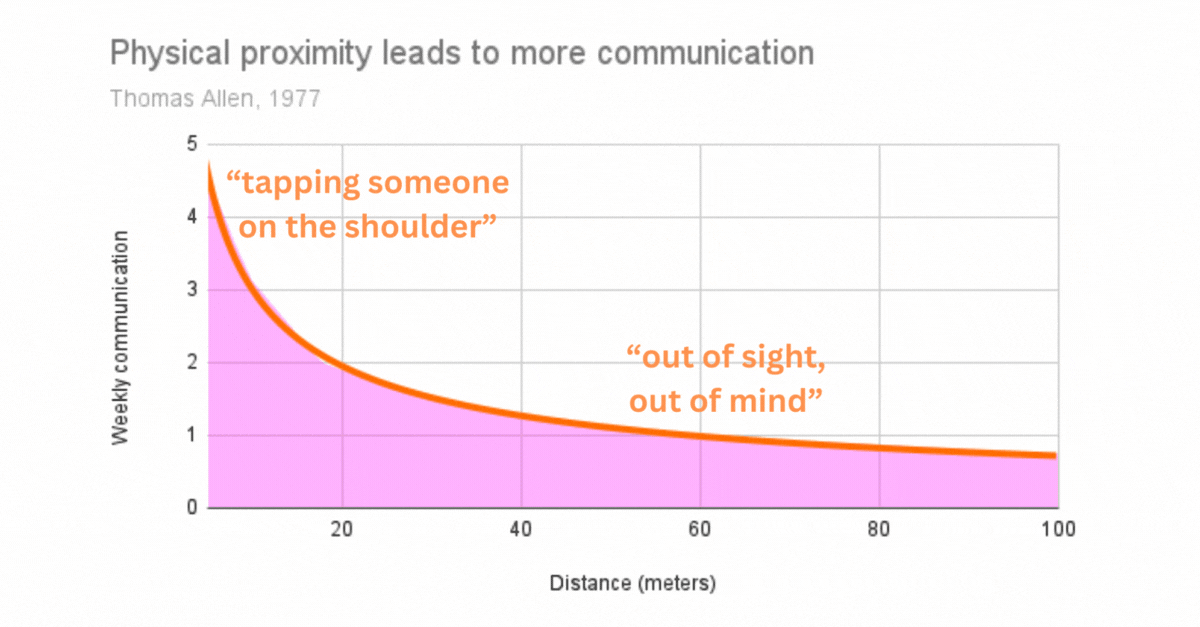The Allen Curve (above) hit the 20th-century office like a meteor, exploding everything in sight. This little chart may well be the genesis of the millennial open-office movement, and for good reason: it clearly shows that people who sit together, work better together.
And yet, this chart represents the world in 1977: the typesetting, mimeographing ice age of communication. Have we accurately applied the lessons of Allen’s discovery to our modern age of distributed teams? In my opinion, we’re getting it wrong.
What’s the Allen Curve?
In 1977, Thomas Allen at MIT set out to learn what made some teams have better chemistry. Why did some people work together in beautiful synchrony, while others struggled to bond?
He looked at the expected factors: personalities, backgrounds, experience. None of them held any special insight. But then, he measured the distance between people’s desks. And there it was:
The most collaborative, communicative & in-sync teams were the ones who sat closest to each other.
That’s it. That’s the special sauce.
Literal physical proximity >> team bonding.
In The Culture Code, Daniel Coyle writes that this makes logical sense, if you think in terms of evolutionary psychology. For most of human history, we stuck together in small groups where we had high psychological safety and belonging. When you feel safe, and feel like you know the people around you, you open up to them; and more importantly, you tune into them. Collaboration becomes second nature, as micro-interactions increase and we gain the ability to perceive each other’s thoughts almost instinctively.
At the left of the Allen Curve are teams who sit closest to one another: they’re also the ones who communicate most frequently. The curve drops steeply, then levels out into a long tail. As Coyle also points out, the key to understanding the Allen Curve is that steep drop-off at the left side. Teams that sat within a few meters of one another were highly communicative. But at a distance of eight meters, that communication dwindles. Beyond 20 meters, it’s more or less “out of sight, out of mind.”
The open-office revolution ensues
The Allen Curve was part of a movement in social/organizational psychology that completely reinvented how we thought about office design. It truly was a revelation to learn that one of the foundational elements of success was something as simple as familiarity. Suddenly, we realized that innovation was an organic process – and we sought to unblock it, literally.
Office architecture did an about-face. GONE were the offices with doors that closed! GONE were private meeting rooms! GONE were all the blinds and curtains on our windows! GONE were the WALLS KEEPING US APART: people welcomed a glorious new age of open-office layouts, “collaboration pods,” walls-free brainstorming spaces, and cool hangout zones where everyone could get completely up inside everyone else’s business, at all times.
I’m teasing. This was actually a great idea. We overdid it, but the rationale was solid. Let people be people; let us connect naturally, in micro-interactions, as social animals. Kill formality and create more closeness and camaraderie.
And then remote work came along.
I don’t think “closeness” means what you think it means
In my work, I am asked daily about the challenge of creating connection among remote teams. It’s an endless topic of interest. Leaders commonly recognize that people want to work remotely; they also note with concern that remote workers feel less connected, more lonely, less motivated.
There’s no digital experience that can replace the feeling of meeting with people in person (“in meat space,” as we call it in the industry). Our brains light up wen we’re using all five of our senses to perceive people. We are immersed; we read everything from micro-gestures, to tone of voice, to physical proximity; we even gain familiarity by smelling one another. There’s a huge body of research behind this: no virtual experience, no matter how immersive, can replace what we get from being together in person.

A lot of remote-first companies are working hard to answer this question: how can we get our people together in person often enough, intimately enough, to help them build and maintain deep, meaningful connections?
This, unfortunately, is the wrong way to ask the question.
In 2018-19, I was part of a team that had members on six continents. We never had a single offsite. We only worked together for a year or so. Yet to this day, some of those people are my dearest friends. I recently met one of them in person for the first time – at her wedding.
How did we get so close, without ever needing to meet?
My next employer – GitLab, now a publicly-traded company – started as an open-source project. Its founders had always worked remotely, but they were told they’d work better if they got an office. So they did.
Just one problem: nobody came to the office.
The work was getting done, but the team didn’t want to sit in a room together.
They were more productive, more collaborative, more effective without it.
If you’re reading this, you probably don’t have any trouble believing these stories. So how do we reconcile this with the Allen Curve? If teamwork is correlated to closeness, how do teams bond without physical proximity?
You know the answer to these questions intuitively. Have you ever sent somebody five DMs in under a minute? Ever had a friend or family member send you a “good morning, hope you have a great day” message the moment they woke up?
Ever had a private chat channel at work where your team shitposted all day long?
It felt like connection, didn’t it? Like closeness.
I think we’re looking at the Allen Curve all wrong. We’re distracted by what was true in 1977: you couldn’t chitchat with your teammates unless you sat next to one another.
The year is 2024. That is simply no longer the case.

Think smaller, spend less: Offsites aren’t the only solution
Offsites (company retreats, gatherings, summits…) are great! Offsites serve that key function of building deep, meaningful connections and helping us get to know one another as full, individual and unique people. But an in-person experience represents less than 1% of a remote-first team’s time. What happens in the other 99%+?
We’re focusing too much on the rare, big events. Instead, we should be thinking about the little things: the day-to-day ways for people to share their lives. I’m not talking about company culture; I’m talking about the smallest unit of your work life. Your immediate team.
In 2018, my close-knit team had a private Slack channel with a fun name – and where our manager wasn’t a member. We shared our ideas, thoughts, our lives; supported one another; planned for the future; and thrived. That’s all we needed: just a single private space where we could relax and chat.
I’ve encountered remote teams with high levels of connection and engagement, and teams with almost no sense of connection. Creating a vibrant, high-connection space for a work/project team requires just two things:
- Psychological safety
- Immediacy
Psychological safety works on many levels (please, read more about it), but structurally, it just means creating a space where members feel comfortable and relaxed enough to be vulnerable and share ideas, free from a fear of judgment.
Immediacy just means there’s a very short time between when I send a communication and when you receive it. Logistically, this usually means we’re using a chat tool.
When people can chat openly with their teams in real time, they connect. This is what it means to have a close, active, open relationship. It’s about freedom of expression and the ability to brainstorm. It’s so simple, we almost overlooked it.
The Allen Curve is not telling us that people need physical proximity. It’s saying we need psychological proximity: familiarity. Intimacy. Safety and acceptance. Those are the factors that have always been important to humans, and those factors will never change. The difference between 1977 and now is that we have technological tools that help us bond across thousands of miles. We just have to trust ourselves to use them.
Manager guide: How to create a high-engagement remote team environment
Here, I’m talking about small teams: project teams, work teams. Groups of 20 or fewer, down to as small as three or four. I’m referring to the people who share work and who rely on each other every day.
There are many different touchpoints you can use to create day-to-day connection. Here’s one potential model. If you’ve got your own model and it’s working, please leave a comment or get in touch; I’d like to hear about it.
1: High-touch onboarding
This is different from corporate onboarding – this is how the manager introduces and connects a new team member to an existing team.
Start with team bonding from day one. Do icebreakers. Spend an entire team meeting asking the new person questions and letting them ask questions. Come up with some inside jokes right away. (Though please, for the love of humanity, do this inclusively and with respect to cultural differences and personal preferences!)
2: Create a safe space
Figure out what’s right for your team. A private chat channel is a great place to start (and yes, if you think it would be more comfortable with no manager in the channel, make it so). Don’t overthink this: pick a key tool where people are communicating anyway, and designate a chat zone. Even better, tell the team to find or create their own chat zone. Make it clear that getting to know one another is a priority, and socializing isn’t a waste of time.
3: Check in regularly
If you’re the manager, pick your moments. Do regular psychological safety check-ins with everyone on your team. If morale seems to be flagging, investigate. If people aren’t connecting, find out why and resolve the issue. Make your team’s vibe your personal mission. And then, get out of the way and let it flow.
4: If you can, get together in person
If there’s any way you can bring the entire team together at the same location and time, make it happen. If you can’t get everyone together, find a different model: could you break it into smaller groups? Do you need to be the one who travels? Could you find another event to glom onto? Don’t ever create a dynamic where almost everyone is able to attend. If someone is excluded, redesign it.
If you truly can’t get together in person, relax and just don’t do it.
Closeness isn’t all about physical location.
Really, truly, it isn’t.

